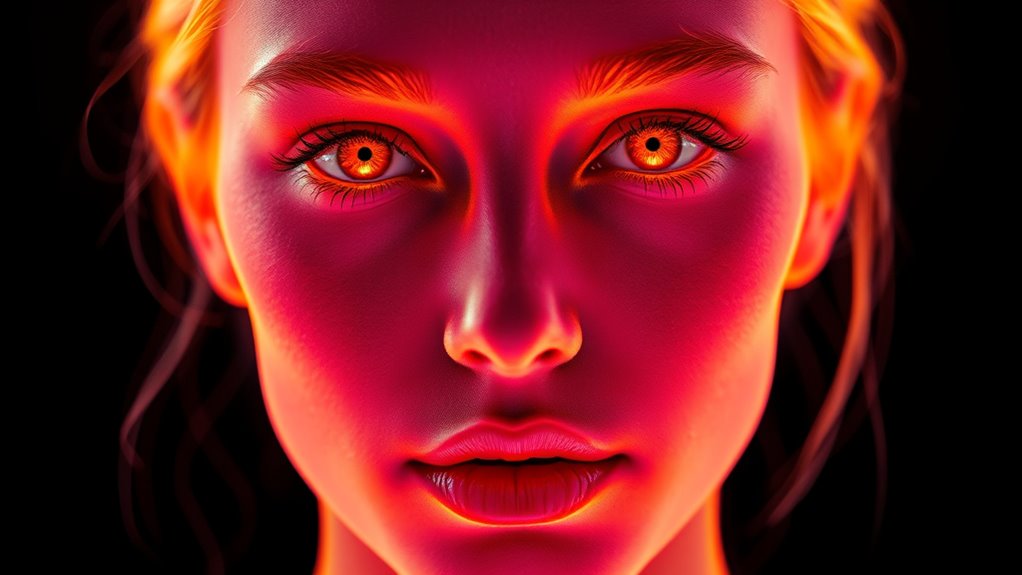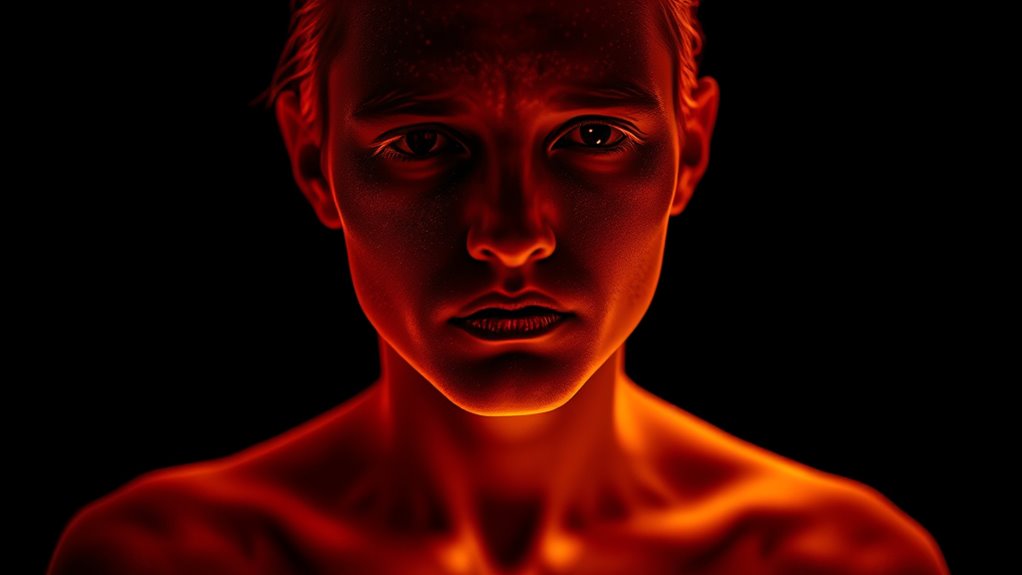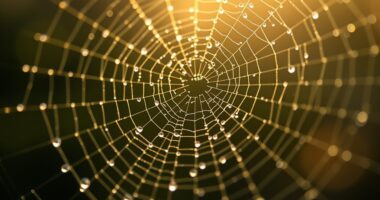Infrared portraits capture your body’s heat signatures, transforming them into striking works of art. By using thermal imaging, you reveal unseen layers of your identity, emphasizing heat patterns instead of colors and textures. This approach creates images that feel intimate, mysterious, and otherworldly, blending science with creativity. You can experiment with various settings and enhancements to evoke different moods. To discover how this unique art form can elevate your portraits, explore further insights here.
Key Takeaways
- Infrared portraits use thermal imaging to visualize heat signatures, revealing unseen details beyond visible light.
- They transform traditional portraits into artistic representations emphasizing temperature contrasts and natural heat patterns.
- This technique allows artists to explore emotional depth and surreal effects by manipulating heat data.
- Creative options include adjusting heat emphasis, applying filters, and post-processing for unique visual expressions.
- Infrared portraiture blends science and art, offering a novel perspective on human presence and identity.

Have you ever wondered what a portrait looks like beyond visible light? With infrared photography, you step into a world where heat signatures tell a story far richer than mere appearance. By using thermal imaging, you can capture a person’s unique heat pattern, revealing details that the naked eye never perceives. This approach transforms traditional portraiture into a form of artistic expression that blends science and creativity seamlessly. Instead of focusing on colors and textures, infrared portraits highlight temperature differences, creating otherworldly images that evoke emotion and intrigue. When you employ thermal imaging for portraits, you’re not just capturing an image—you’re translating the subtle warmth of a person into a visual language that’s both abstract and deeply personal.
Infrared portraits challenge the conventional idea of a portrait, pushing boundaries to explore unseen layers of identity. The thermal signatures traced out by the heat emitted from skin and clothing become a canvas for artistic experimentation. The glowing regions can emphasize the natural contours of the face or create surreal effects, depending on how you manipulate the imaging process. This technique allows you to emphasize mood, emotion, or even hidden aspects of a person’s character by exaggerating or de-emphasizing heat variations. As a result, you’re able to craft images that evoke mystery and intimacy simultaneously.
Using thermal imaging is also a way to explore new artistic horizons. It invites you to think about how heat, a fundamental aspect of life, can serve as a medium for expression. You might experiment with different settings, filters, or post-processing tools to enhance the warmth contrasts or add a dreamlike quality to your portraits. Additionally, understanding essential oils can inspire a sense of calm and focus during your creative process, enriching your artistic experience. As you do so, you’re embracing a form of artistic expression that’s rooted in the physical sciences but driven by your creative instincts. Infrared portraits, thus, become a hybrid art form—part science experiment, part emotional storytelling.
In this process, you’ll find that infrared photography offers a fresh perspective on human presence. It strips away surface details, revealing instead the underlying energy and vitality of your subject. Through thermal imaging, you can create portraits that feel intimate yet mysterious, familiar yet alien. This technique encourages you to see beyond the surface and explore the deeper layers of human existence. So, when you pick up your camera to capture an infrared portrait, remember—you’re not just taking a picture; you’re translating heat into an artistic language that’s as expressive as it is innovative.
Frequently Asked Questions
Can Infrared Portraits Reveal Hidden Emotional States?
You wonder if infrared portraits can reveal hidden emotional states. While they primarily detect heat signatures, they can offer emotional detection insights by highlighting physiological changes linked to emotions. These portraits can provide psychological insights, showing subtle variations in body temperature associated with stress or excitement. However, they don’t directly read emotions but serve as a tool to observe physical responses that hint at underlying feelings.
What Equipment Is Necessary for Infrared Heat Signature Photography?
Imagine uncovering hidden details in your photos—what equipment could open this secret? To do infrared heat signature photography, you’ll need specialized gear. Infrared filters allow you to see beyond visible light, while thermal cameras detect heat signatures. These tools reveal unseen layers, transforming ordinary portraits into extraordinary artworks. With the right equipment, you hold the power to explore an unseen world of warmth and emotion, waiting to be captured.
How Does Infrared Portraiture Differ From Traditional Portrait Lighting?
You notice that infrared portraiture differs from traditional portrait lighting because it relies on thermal contrast rather than visible light. Instead of highlighting skin tones with standard lighting, it captures heat signatures across specific wavelengths spectrum. This approach reveals temperature variations, creating unique images based on heat emission. You use specialized infrared equipment to visualize these differences, giving your portraits a distinctive, otherworldly quality that traditional lighting can’t achieve.
Are Infrared Portraits Safe for Subjects and Viewers?
Infrared portraits are generally safe for subjects and viewers when proper safety precautions are in place. You should ascertain the infrared equipment complies with health and safety standards to minimize any potential health implications. While infrared radiation is non-ionizing and unlikely to cause harm, it’s still wise to limit exposure time and avoid direct eye contact with intense infrared sources. Always follow manufacturer guidelines for safe use.
Can Infrared Heat Signatures Be Used to Enhance Digital Art Projects?
You can definitely use infrared heat signatures to enhance digital art projects. By applying thermal color palettes, you bring a unique, vibrant look that captures heat variations creatively. Infrared overlay techniques allow you to blend heat signatures seamlessly into your artwork, adding depth and intrigue. This approach offers a fresh perspective, transforming ordinary digital pieces into mesmerizing visuals that showcase heat patterns in an artistic way.
Conclusion
As you step back from the glowing canvas of infrared portraits, you see heat’s silent poetry—the fiery reds and cool blues revealing hidden stories beneath skin. The warmth dances like flames, painting emotions in thermal hues. This art form transforms ordinary faces into mesmerizing landscapes of heat, inviting you to explore unseen worlds. With each portrait, you hold a secret universe, alive with color and energy—an enchanting reminder that beauty often lies beneath the surface.









